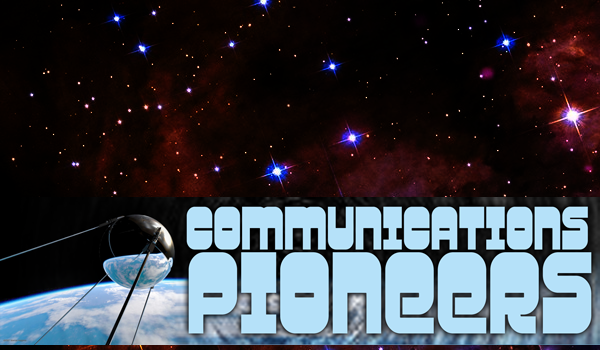Sadly, the name of Arthur C. Clarke has faded into history and most people today have no idea who he is. Audiences of the 1960s knew him as the force behind 2001: A Space Odyssey but here in 2019, eleven years after his death, he’s a fairly obscure figure. Yet, he remains one of the most influential figures in the history of communications… not for his fiction but for a letter he wrote in 1945, published in Wireless World. It said, in part,
An “artificial satellite” at the correct distance from the earth would make one revolution every 24 hours; i.e., it would remain stationary above the same spot and would be within optical range of nearly half the earth’s surface. Three repeater stations, 120 degrees apart in the correct orbit, could give television and microwave coverage to the entire planet. I’m afraid this isn’t going to be of the slightest use to our post-war planners, but I think it is the ultimate solution to the problem.
(You can see the whole letter in scanned and text format here.)
Dr. Clarke, a writer, scientist and eventual Knight Bachelor of the British Empire, was the first person to propose what we know now as geostationary orbit. He later expanded on the idea in the same magazine; read the whole article and see if it makes sense to you.
Of course, it all remained theoretical until the first communications satellites were launched in the 1960s, but it’s such a common idea today that it’s hard to believe that Dr. Clarke was often dismissed as “just a science fiction writer.”
He was not “just a science fiction writer…”
…even if he had only been a science fiction writer, he was one of the key figures in fiction writing in the 20th century. When Mr. Clarke started writing, science fiction belonged to children. People thought stories of rockets and aliens were purely for immature minds. No reputable magazine would publish it. People looked at it in the same way they looked at trading cards and board games.
The science fiction writers of the day kept low profiles, generally worked day jobs, and contented themselves with short stories often under assumed names. By the 1960s, that started to change because of Arthur C. Clarke and his contemporaries.
Mr. Clarke had written a lot of very interesting and thoughtful short stories, but filmmaker Stanley Kubrick approached him in 1964 to create a science fiction film like no other. Science fiction movies were poorly regarded by critics. Like published sci-fi, they were thought of as kiddie material, full of simple plots and silly-looking monsters. Kubrick and Clarke took one of Clarke’s short stories and evolved it to become one of cinema’s greatest masterpieces: 2001: A Space Odyssey. This film is still amazing even today and while it does seem slow and dry by today’s standards, the effects are still surprisingly good. The themes it brings up are even more relevant today. All of a sudden, critics began to notice science fiction.
Today, the biggest moneymakers in television and film are science fiction of some sort. The genre is so big and so pervasive that we don’t even think about it. Any sort of film that takes place in the near future with technology that doesn’t exist in real life is rightfully science fiction, and none of it would be possible without Arthur C. Clarke.
Last words…
Imagine a movie about advanced technology in satellites like Geostorm. When it is shown on a satellite TV service, we have to thank Arthur C. Clarke, probably about 3 times. That’s far more than a crummy film like Geostorm deserves, but still something to think about.




